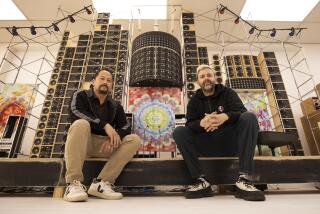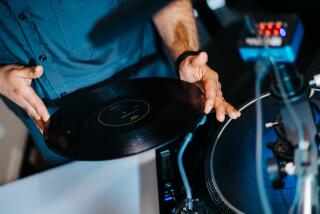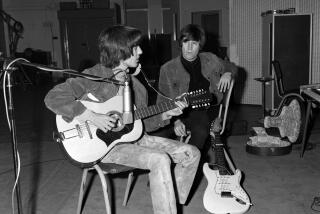Made in California: Fender an instrument of change in guitar industry

Fender guitars, amplifiers and basses have always been made in California (except for the low priced Squier line) even though the company moved its corporate headquarters to Arizona.
- Share via
Deep inside a cavernous factory in Corona, some legendary rock names gather nonchalantly along a wall.
There’s Eric Clapton next to Jeff Beck, with Mark Knopfler only inches away — not the actual musicians, but the bespoke guitar necks that those performers prefer bolted to their Fender Stratocasters.
Since 1946, the company founded by Leo Fender has catered to the famous and talented, and those who want to emulate them. These days, executives at Fender Musical Instruments Corp. are looking to build on that legacy as they move beyond echoes of an aborted initial public offering, ownership shifts and management changes.
Fender counts itself as a leading maker and distributor of electric guitars, basses, amplifiers and other instruments and accessories, selling about $700 million a year under names that include Fender and Squier.
This year, the company has been busy celebrating the 60th anniversary of the Stratocaster by releasing several limited editions and a variety of other new products. Fender also recently unloaded the Guild acoustic guitar brand for an undisclosed amount and is beefing up international sales, particularly in China.
The company has just added a “design your own” guitar feature to the Fender website. That effort has created waves in music circles for its embrace of the direct-to-consumer sales model, which cuts out the company’s traditional dealers.
Fender’s instruments “have always been modular in construction, which has always made them ideal for individual personalization,” said Justin Norvell, Fender’s vice president of product marketing. The design-your-own initiative “also provides us with valuable marketing data as to what options, colors, etc. consumers are looking for in a Fender instrument,” he said.
Like a good guitar riff, Fender has had its ups and downs.
Fender’s first guitars were mocked at trade shows for their solid wood bodies and the way the necks joined the bodies with bolts and screws rather than glue.
“Leo Fender started out as a radio repairman,” Norvell said. “It was all about being serviceable and utilitarian. He said if he had $100 to make something he would spend $99 making it work and $1 making it pretty.”
Fender has been credited with design and manufacturing innovations that revolutionized the world of electric guitars and basses. The Stratocaster body introduced a curvy ergonomic design for ease of playing and incorporated tonal advances suggested by musicians.
Although corporate headquarters is in Scottsdale, Ariz., the company has chosen to keep Southern California the manufacturing center for its best guitars: Fenders with prices usually between $500 and $2,500 apiece, although custom instruments crafted by master artisans can be much more expensive. The Corona factory employs between 300 and 400 people depending on demand, Norvell said.
“We’re still making our instruments in California because it’s our heritage,” Norvell said. “It’s the Beach Boys. It’s surf music. It’s our legacy.”
The company’s Squier guitars, which cost from $99 to $399, are made at a company factory in Ensenada, Mexico.
With his health declining, Leo Fender sold the business in 1965 to CBS, which provided uneven backing over the years. In 1985, management and private investors bought the company.
The ownership shuffled again in late 2012 after an initial public offering that never got off the ground. Currently Fender is controlled by majority shareholders Servco Pacific Inc. of Honolulu and equities investor TPG Growth of San Francisco.
Income and revenue took a hit during the recession, according to documents filed with the Securities and Exchange Commission as part of the proposed stock sale in 2012. The IPO was pulled in 2012 amid criticism of the valuation; the company blamed poor market conditions.
The economic downturn wasn’t the only market problem. Fender and other guitar manufacturers have had to contend with the rise of so-called EDM, or electronic dance music, with a synthesized sound that downplays or eliminates guitars.
Changing tastes are reflected in industry sales. U.S. music stores sold $376 million worth of electric guitars and basses last year, down 31% since 2008, according to MI SalesTrak, a New York research firm.
In rating Fender debt last year, Moody’s Investors Service noted risks that included the company’s relatively small size in a competitive industry, “modest operating performance,” heavy debt level and significant sales through the troubled Guitar Center chain. On the positive side, Moody’s said, Fender has well-known brand names, good geographic distribution and a leading market share in guitars.
The company’s latest challenge involves finding a permanent chief executive to replace Larry Thomas, who retired in May. Scott Gilbertson, Fender’s interim chief operating officer since October 2013, is serving as interim chief.
For such a rock ‘n’ roll fixture, Fender maintains a surprisingly low profile in Corona. Its 176,000-square-foot factory operates in a nondescript building in a neighborhood of similar low-rise facilities.
The interior is filled with the sounds and smells of wood being cut, shaped and painted. Famous clients wander through from time to time. A flashy visitors center lets fans see how the instruments evolved and how they can be customized.
A typical Fender takes a month to complete. Usually made from North American alder or maple, each instrument involves 140 hand shaping and smoothing processes, which Norvell said gives Fenders a unique feel.
Singer-songwriter Nils Lofgren, a longtime guitarist with Bruce Springsteen’s E Street band, said he owns more than 50 Fender guitars and amplifiers.
“I love their sound, precision and reliability,” Lofgren said in an email exchange. “I’m extremely aggressive with my guitars and amps, and the Fenders, the Stratocaster especially, handles the aggression with ease and never requires holding back. Yet, they also work well with delicate, cleaner playing.”
Green Day bass player Mike Dirnt put it more simply: “A Fender is the most comfortable guitar to play in rock ‘n’ roll.”
Clapton was Fender’s first signature artist, Norvell said, and the company was willing to make whatever interested him. Once, he wanted a green guitar that mimicked the color of a 7 Up can. Another time he wanted the same shade of blue as his Mercedes.
To build replicas of famous guitars for limited-edition series, Norvell said, the company does forensic examinations involving laser scans, disassembly and caliper measurements.
The Stratocaster that Jimi Hendrix painted before his famous 1967 Monterey Pop Festival performance was difficult to duplicate because Hendrix set it on fire onstage. The few pieces that were left were scattered among collectors. Fender artisans pored over old photographs and archival film footage for their copy.
That kind of attention to detail is “something we’re always thinking about,” Norvell said. “We might be building the guitar that is used to play the next ‘Purple Haze.’”
Twitter: @RonWLATimes
More to Read
Inside the business of entertainment
The Wide Shot brings you news, analysis and insights on everything from streaming wars to production — and what it all means for the future.
You may occasionally receive promotional content from the Los Angeles Times.











